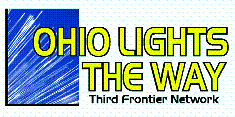 Ohio will soon have some high-tech bragging rights when the Third Frontier Network (TFN) is lit this summer. After nearly two years of development, nearly 100 institutions of higher education and thousands of primary and secondary schools throughout the state will have access to the nation’s most advanced statewide education and research network.
Ohio will soon have some high-tech bragging rights when the Third Frontier Network (TFN) is lit this summer. After nearly two years of development, nearly 100 institutions of higher education and thousands of primary and secondary schools throughout the state will have access to the nation’s most advanced statewide education and research network.
TFN is a technology initiative of the Ohio Board of Regents, and is operated by the Ohio Supercomputer Center’s (OSC) networking division. The Ohio SchoolNet Commission and Ohio Department of Education are also TFN founding members. TFN backbone infrastructure and equipment were purchased with state and federal funds. OSC Networking purchased unused, or “dark fiber,” from several telecommunications companies (Telcos) and service providers to build TFN.
Equipment installation and testing is nearly complete on the 1600-mile backbone that will connect Ohio’s colleges and universities, elementary, middle and high schools, and state and local governments. Medical research centers and hospitals such as The Ohio State University Medical Center, Children’s hospitals in Columbus and Cincinnati, and the Medical College of Ohio in Toledo will also use the new network, as will federal research centers such as NASA-Glenn in Cleveland, and Wright Patterson Air Force Base in Dayton.
“The Third Frontier Network is one of the most important education and research projects in Ohio's proud history, and serves as an example to the nation of how the public and private sectors can collaborate for the greater good of the people,” said OSC Executive Director Stan Ahalt. “The Third Frontier Network will generate many new opportunities, not only for advances in education and research, but also for the economy as we attract and stimulate the creation of new companies to greatly improve Ohio’s economic climate.”
The new network’s massive increase in capacity will provide revolutionary ways for conducting research in fuel-cell technology, cancer treatment, bioinformatics, DNA mapping, and a host of other applications. TFN will also allow children to take virtual field trips and share classrooms around the state and even the world without leaving their schools. It will let doctors see patients across town or across the state without leaving their offices. And it will provide access to OSC’s supercomputers in the blink of an eye.
Ohio’s major universities will start connecting to TFN this spring, and planners say all of higher education should be connected by summer’s end. Primary and secondary schools will also start connecting during the summer as financial and logistical conditions permit.
What is the fundamental difference between the current network and TFN? The current network transmits data over copper wire, while TFN will transmit data over optical fiber (glass) strands. Optical fiber will provide the most cost-effective and scalable solution to higher education’s long-term needs, and can be customized to meet unique research requirements.
“To give you an idea of how much larger this network will be compared to what we’ve got now, imagine a two-lane highway expanding to 32 lanes overnight,” said Third Frontier Project Manager Denis Walsh. “We’ll have the ability to add ‘lanes’ quickly and inexpensively in the future just by adding more equipment instead of laying new fiber. This network is built with the capacity to add 64 ‘highways,’ each with 64 lanes when we need to.”
The lanes in this case are actually wavelengths of light controlled by optical cards installed in equipment on the network. Walsh said TFN also has a dedicated experimental research link between Cleveland, Columbus, Cincinnati and Dayton that will start out at 64 lanes to be used for specific research collaborations.
In addition to the seemingly endless optical fiber capacity is a host of equipment that will make the new network run. Distributed throughout Ohio’s new statewide “information superhighway” are17 network access locations called Points of Presence, or POPs. POPs act as TFN’s on-and off-ramps. They let traffic on and off the “highway” at specific locations. Traffic is then carried by local loops that serve as “last mile” connections to the final destination, such as a campus. Institutions can build, buy, or lease their local loop from Telcos.
Also installed on TFN are highly intelligent devices called routers, which serve as the network’s “post offices”. Routers sort Internet data the same way the post office sorts mail. All data, or “mail,” has a destination address called an Internet Protocol (IP) address. Routers sort this mail based on variables such as privilege, priority, and application being used, and look at traffic on the entire network before deciding the best route. For example, a critical remote medical procedure or supercomputer application would not be competing with lower priority email or Web browsing.
Routers get Internet mail to its destination by either the shortest or fastest path, and can re-route mail to avoid congestion points or network outages. TFN has routers at six major POPs in Akron, Cincinnati, Cleveland, Columbus, Dayton, and Toledo. Smaller routers are located at each campus to provide local routing service.
The current state network has one main routing location in Columbus that sorts and routes all Internet mail. Mail from Cleveland to Youngstown is diverted hundreds of miles out of the way. The new state network, TFN, will reduce this “hop count” by routing mail more directly to its destination, saving time and reducing network traffic.